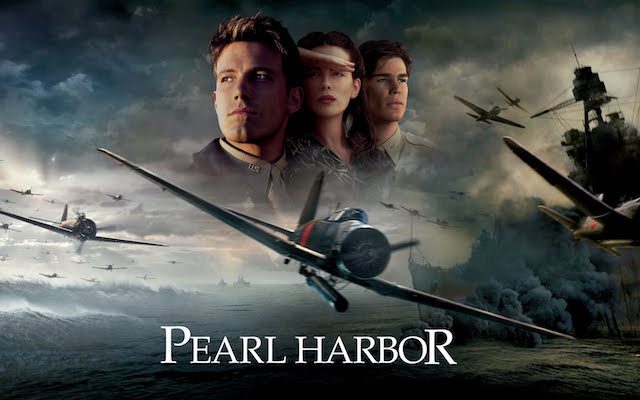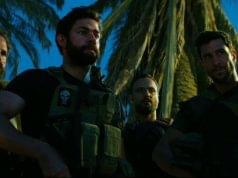
May 25, 2001: a date which will live in infamy. It was on this Memorial Day Friday that Michael Bay’s “Pearl Harbor” was released to widespread derision from critics. Widespread, but not universal. Among the 25% of reviews that were positive was one written by Eric D. Snider, who is me.
Go ahead and laugh! Enjoy my shame! But keep in mind, at this point Michael Bay had only made “Bad Boys,” “The Rock,” and
“Armageddon,” all disposable and entertaining to some degree, if not exactly “good.” When I told people that “Pearl Harbor” was worth seeing, no one was flabbergasted, the way they would be if you had nice things to say about a Bay movie today. He wasn’t really “Michael Bay” yet then.
Nonetheless, as “Pearl Harbor’s” reputation grew more notorious over the years, I started to fear what might happen if I watched it again. I had a sneaking suspicion that my views would change. At last, with a great deal of pride-swallowing, not to mention an incentive (I had to write something this week), I caved in and gave it another go.
What I said then:
“A three-hour movie featuring a fictional love triangle set against a historic tragedy in which the action scenes are far better than the romance scenes. Yes, ‘Titanic’ was a good movie. But we’re talking about ‘Pearl Harbor,’ which is a great deal better. The film is easily divided into two halves: The mediocre half and the excellent half. The mediocre one comes first, unfortunately, as for the first 90 minutes a sterile, perfunctory romance is established…. Thus begins the excellent half of the movie, which commences with a 30-minute attack sequence that is ungruesome — no severed limbs or gushing blood — and yet terrifyingly realistic. Director Michael Bay … delivers the goods this time. His long tracking shots that follow the bombs as they drop from the planes are more than just cool gimmicks. They’re exhilarating moments that bear the mark of near-genius…. It is rare that a movie lives up to its hype, and this one doesn’t…. It assumes viewers will care about the love triangle without giving them much reason to. But when it is good, it is spectacular. When it’s over, the positive feelings have outweighed the negative ones, and ‘Pearl Harbor’ will go down as a success.” Grade: B+ [complete review]
You know what else I hadn’t done in a long time? Read my review of “Pearl Harbor.” I knew it was a B+, and I knew I’d gotten some grief for it over the years, but MAN ALIVE. Did you see the part where I said it was “a great deal better” than “Titanic”? I must be the only intelligent adult who has seen both movies who has ever held that opinion. Or what about when I said the awesome bomb-dropping shots “bear the mark of near-genius”? It’s hard to live down using the term “near-genius” in your review of “Pearl Harbor.”
I’ll say this much for myself: at least I didn’t water down my opinions out of fear they’d be unpopular. You have to be brave enough to say what you think, even if what you think is insane. This review accurately reflects how I felt about the movie when I first saw it, so I stand by it in that regard.
The one actual “mistake” I made was saying the movie “will go down as a success.” As a critic who’s really smart and professional and awesome now, I cringe when I read that, because it’s a bad idea for a reviewer to make predictions. “It will stand the test of time”; “sure to be a favorite for years to come”; even “an instant classic” — those are dangerous words. People already think critics are know-it-alls, and pretending we can see the future is not going to help that perception.
One more thing about this review. If you read the whole thing, it doesn’t sound like a B+. The amount of criticism it includes, even balanced with the praise, feels more like a B, maybe even a B-. In those days I would jot down my gut-reaction grade as soon as the movie was over, to remind myself how I felt at that moment, and I was sometimes hesitant to second-guess myself by deviating from it. Now I frequently change grades over the course of writing a review, and sometimes don’t even assign one until it’s finished. Like I said, I’m a lot more awesome now.
The re-viewing:
Well, no wonder the movie is so long. It starts in 1923! The prologue, with those two hick kids flying a plane and being best friends and whatnot, made me fear the worst for the re-viewing. “What have I done?” I asked myself. I grew more despondent as we jumped ahead to 1941, with stock characters saying generic lines, and soldiers doing dumb things to get the nurses’ attention, and Affleck and Hartnett doing goofy Tennessee accents. (“Please don’t take my wangs!” Affleck says, presumably meaning “wings.”)
Then there’s the soldier who has a stammer. I had forgotten about him.
I hadn’t forgotten about FDR’s giant comedy chin, though! All the money this movie cost and they couldn’t come up with a better prosthetic for Jon Voight? Also, remember the time when FDR stood up from his wheelchair just to make a point? FDR will not take this war sitting down!!
Since America’s not in the war yet when the film starts, but since it’s illegal to make a war movie that doesn’t cast Americans as the heroes and saviors in every situation, “Pearl Harbor” sends Affleck overseas to help the Brits. Naturally, he’s a better fighter pilot than any of them. One of his British officers says, “If there are many more back home like you, God help anyone who goes to war against America!” “Team America: World Police,” which was inspired by movies like this one, said it best in a song called “America: F*** Yeah!”
Then Affleck comes back from the dead and is kind of a bastard to everyone because he assumed that his girlfriend would remain celibate for the rest of her life after he died.
Oh, and Kate Beckinsale is obviously pregnant, because she’s nauseous. Pregnancy is the only known cause of nausea in female movie characters.
But then — THEN the attack happens. Regardless of what cheesy things we have endured prior to it, this sequence, comprising about 35 minutes of the film, is a fantastically thrilling depiction of war, and it isn’t cut together in the confusing, chaotic manner of many Bay-directed action scenes. It’s more than just blowin’ stuff up, too. Bay captures the size and scale of the attack, the horror and excitement of it. The dialogue continues to be corny — but I would remind you that this is the case with most war pictures. I don’t think Affleck saying “Get me to a damn plane!” (not once but twice) is any worse than what you hear in a typical World War II-themed B-movie.
Then, of course, it’s back to the love-triangle nonsense, and the resolution of Affleck and Hartnett’s interpersonal bro problems, and the convenient death that simplifies everything. This is where you roll your eyes and look at your watch a lot. Maybe — MAYBE — you even fast-forward the DVD a little bit.
Now here’s the thing. My reaction to the movie the second time is actually pretty close to what it was the first time: lots of mediocrity and hokeyness and dopiness, but not a lot of things that I would say are downright BAD. I can see hating certain elements of it, but the overall effect — even without the fine bombing sequence in the middle — is that it feels harmlessly dumb and generic, not rage-inducing. Trust me, I was open to the possibility that I would loathe the movie this time around, and I was somewhat surprised that I didn’t. The only main difference between how I feel now and how I felt ten years ago is that the good doesn’t outweigh the mediocre anymore.
Do I still love this movie?
No, but I really don’t think it’s terrible, either. It has some terrible components, and some terrible scenes, and some terrible characters, but not enough to totally ruin everything. I’m not saying the movie is good overall, only that it isn’t a complete travesty. If it hadn’t been three hours long and kind of bombastic and directed by Michael Bay, we might have disregarded it entirely. Grade: C
— Film.com




